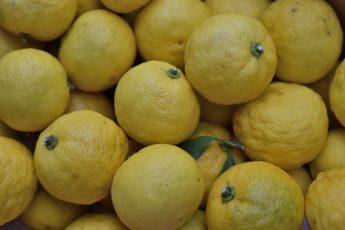Now and then, you may have a craving for sushi or anything part of Japanese cuisine. That is why Japanese steakhouses are such a hit with so many people. When you go there, and it is time for dessert, the wait staff often brings you fruit that you may not recognize.
That is because they will get you a part of some Japanese fruit, and they are always so delicious. You can find any fruits and vegetables from foreign countries in the produce section. These fruits have plenty of essential nutrients and are fantastic snack options.
Are you ready to learn about some fruits from Japan? Then, let’s begin to learn about Japanese fruits!
Japanese Fruit Names
 Japanese Apple Or Ringo
Japanese Apple Or Ringo
There is a large variety of apples that you see at your local grocery store. You may not overthink where the apples come from that you see in the produce section of your grocery store. However, Japanese apples or the Ringo are a common fruit in Japan, and Japan exports its apples yearly to other countries worldwide.
You will find different apples in Japan as the most common one is the large red and crispy Fuji apple. The small Japanese town, Aomori Prefecture, is the area where farmers cultivated the Fuji apples.
However, many people think that the inspiration for naming the apples derived from Mount Fuji is untrue. Japanese apples are in season during the fall and early winter.
Find out about more vegetables and fruits HERE.
Nashi Or Japanese Pear
You may think that the nashi is the same as domestic or Western pears. However, Japanese pears are pretty different. That is because they are large compared to Western pears and are also crispier. In addition, they feature rough skin but have a lighter taste than Western pear.
Domestic pears have the shape of a pear, which is the reason that the term pear-shaped exists. However, the nashi is shaped like a sphere, and you have to eat them after peeling the skin. The times that nashi is in season are during the late summer to autumn.
So, the next time you go to your grocery store, why not give nashi a try.
Mandarin Orange Or Mikan
The mikan is also known as the Mandarin orange, and they are a prevalent Japanese citrus fruit. You can find mikan at your local grocery store. The appealing thing about these oranges is that they are effortless to peel and do not contain seeds.
Therefore, you can peel them quickly and not have to worry about spitting out seeds each time you eat an orange slice. They are also quite sweet and can be a trendy and healthy snack.
Mikan is in season during the early part of winter, and that is when many parties in Japan include this fruit. Japan exports mikan widely.
Kaki Or Japanese Persimmon
You can say that the kaki is a cross between the nashi and the ring because they share the same level of crispiness, size, and shape as those fruits. They are also sweet in flavor, and after peeling the skin, you can enjoy them raw.
You may prefer to cut this fruit into different pieces, and you can also dehydrate them. When you dehydrate kaki, it has the same texture and flavor as figs.
When this fruit is in season is during the late fall and early winter, and you will see them hanging from trees that no longer have leaves.
Yuzu
The yuzu is a Japanese lemon as they have the same appearance as Western lemons though they are rounder. Yuzu is also quite sour and has a distinct fragrance from Japan. There is not much pulp that comes from yuzu after you juice them, but yuzu pulp is often used for garnishing Japanese cuisines.
This fruit is in season during the winter, and there is a winter solstice celebration that the Japanese participate in that involves this fruit. The Japanese place the yuzu into a hot bath for the fragrance and provide so many different health benefits. It is like taking a lemon bath.
Kinkan Or Kumquat
The kinkan or kumquat is a fruit that has the appearance of the orange, but you can eat them whole without needing to peel the skin. However, the kinkan contains seeds and a lot of pulp and has a sour flavor, but it is more pleasant than yuzu.
Marmelade and a sweet liquer are made from kinkan. Kinkan is in season during the winter, and that is when you will see the Japanese include this fruit in their dessert menus.
You may find this fruit as well at your local supermarket or Japanese restaurants. However, there is no guarantee.
Sudachi
The sudachi is like a Japanese lime as it is green and small and is similar to the yuzu. The fruit contains more pulp than yuzu, but the flesh is rarely eaten as a whole. Instead, many Japanese dishes include sudachi, especially for flavoring grilled fish.
The time when this fruit is in season is during the winter. The production of sudachi happens in Tokushima Prefecture, and that is the place that has the strongest association with the fruit.
Conclusion
Japanese fruits are popular among Western cultures because they have a pleasant sweet taste, and some fruits can be sour. Therefore, when you go to your local grocery store‘, why not look for a lovely Japanese fruit such as the Mandarin orange or the Fuji apple. You will have an easier time finding these fruits since Japan exports them more than the other fruits.
However, you may try different fruits if you go to authentic Japanese restaurants or at a Japanese grocery store‘.
If you ever decide to visit the country one day, you can also give any of these fruits a try!
Interested in finding more about gardening, fruits, and landscaping, CLICK HERE.

